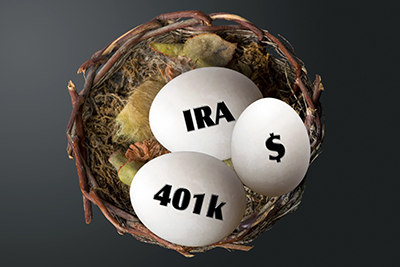 In December of 2019, Congress passed a new piece of legislation called the “Setting Every Community Up for Retirement Enhancement” (SECURE) Act. The goal of this overhaul was to address problems and inadequacies with past laws and to increase Americans’ access to retirement savings. As a result, many clients have been asking, “how will this impact my retirement and estate planning?” Today, we’ll go over the essentials of the new law and discuss its broad implications.
In December of 2019, Congress passed a new piece of legislation called the “Setting Every Community Up for Retirement Enhancement” (SECURE) Act. The goal of this overhaul was to address problems and inadequacies with past laws and to increase Americans’ access to retirement savings. As a result, many clients have been asking, “how will this impact my retirement and estate planning?” Today, we’ll go over the essentials of the new law and discuss its broad implications.
Key changes to retirement laws
The SECURE Act:
- Went into effect January 1, 2020.
- Changed rules around required minimum distributions (RMDs)
- Removed the IRA contribution age limit for individuals with earned income
- Set a 10-year time limit for non-spouses to draw down funds from inherited IRAs
- Improved 529 saving plans
- Makes it easier for employers to use annuities in 401(k) plans
- Expanded retirement options for small businesses
- Lowered the hour requirements for access to employer-sponsored retirement plans
Changes to IRAs, 529 education savings, and 401(k) plans
- IRA Minimum Distributions Age – A major change related to distributions is that the required minimum distributions (RMDs) age was raised by 1 ½ years from 70 ½ to 72. Today, older Americans are working past traditional retirement age with increasing regularity, and so the SECURE Act has updated current rules to reflect this trend. Prior to 2020, individuals were required to start RMDs at the age of 70 ½, but now withdrawals aren’t required until the age of 72. You should note that the increased RMD age could carry new tax implications.
- IRA contribution age limit – Starting in the tax year 2020, there is no longer an age limit for putting money into a traditional IRA. Previously, individuals could no longer contribute once they started drawing RMDs, meaning age 70 ½ was the contribution cutoff. With the passage of the SECURE Act, anyone with earned income can contribute to a traditional IRA, regardless of their age. This allows for increased savings overall that you can enjoy in retirement or pass on to your loved ones.
- Inherited IRAs – It’s important to note, that SECURE won’t affect IRAs inherited from someone who passed away before January 1, 2020. However, starting this year, the law will place some new restrictions on distributions, such as the number of beneficiaries who can receive payments. Instead, those with inherited accounts will have a 10-year window during which they must draw down payments, with a few notable exceptions. First, the 10-year limit doesn’t apply to surviving spouses, children under 18, or legally-dependent adults. Second, beneficiaries who are less than 10 years younger than the account holder are also exempt. While there aren’t required minimum distributions, in most cases, the funds must be drawn down within 10 years of the death of the policyholder. For working survivors, this could mean a temporary move into a new tax bracket, meaning an increased tax burden.
- Changes to 529 plans: As we’ve discussed in the past, 529 savings plans are a tax-deferred way to contribute to a fund used for higher education expenses. In the past, these plans were available exclusively for college and K-12 related expenses, but the SECURE Act extended these plans to also include eligible apprenticeship costs. Additionally, individuals can also now repay up to $10,000 of student loan debt, tax-free.
- Annuities in 401(k) plans – One major change that the SECURE Act made to retirement plans is that it allows more employers to offer annuities as part of their 401(k) saving plans. The main benefit to annuities is the fact that they provide income for the duration of the retiree’s life. For many folks, annuities make financial planning simpler by making payouts more certain.
- Qualified deferred annuity contracts – Just like with traditional IRAs, the SECURE Act increased the RMD age from 70 ½ to 72 years of age for qualified deferred annuity contracts.
- Increased options for small businesses –The SECURE Act expanded retirement plan options for small businesses. For starters, there’s a $500 per year tax credit for employers who create a SIMPLE IRA plan or 401(k) with automatic enrollment. Additionally, the SECURE Act lowered the number of hours required for long-term part-time employees to access savings plans. Starting in 2020, employees can qualify for saving plans if they worked one full year of 1,000+ hours, or 3 consecutive years with at least 500 employed hours.
What does this mean for me?
As with any new law, we’re still waiting to see how all of these changes function in practice. You may need to adjust your retirement and estate plans to ensure that you have access to the funds you’ll need in retirement.
For instance, it’s important to note that while annuities through a 401(k) plan may be a good option for many individuals without pensions, they’re also more complicated than other typical retirement savings products. Failing to use the annuity properly can actually result in larger penalties than with other saving plans, making it essential to understand changes with the SECURE Act and the implications for your nest egg.
The biggest takeaway should be that this overhaul has far-reaching tax and planning implications for your retirement fund. As such, it’s important to review your retirement and estate plans to ensure that they still make sense for you and your family.
If you need help making sense of the new SECURE Act, consult with a trusted financial advisor. Contact Holdfast Wealth Management today.
